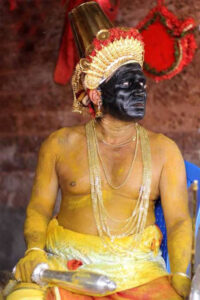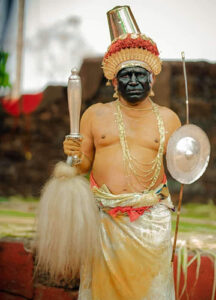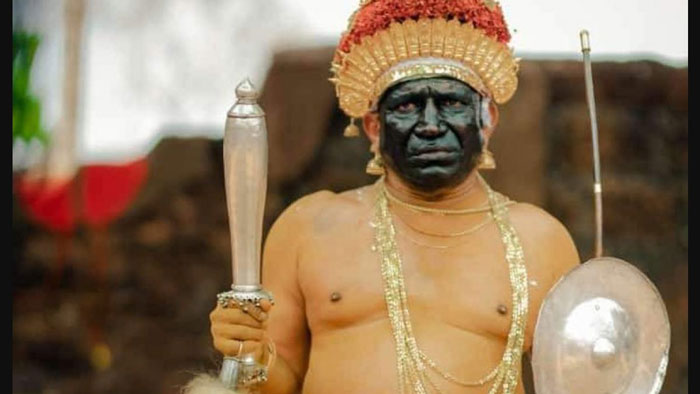The land of North Malabar known for its vibrant culture and traditions has long been celebrated for religious harmony and unity. Among its many unique cultural practices, it stands out as a captivating ritual art form that brings communities together.

It is interesting to observe that the traditional art form of Theyyam occasionally incorporates subtle elements that evoke reflections on communal harmony and coexistence. This unique aspect serves as a testament to the enduring spirit of interfaith understanding and tolerance that prevails in this culturally rich and diverse region.
These expressions are particularly evident in the representation of Muslim deities in Theyyam despite their limited number.

Ali Mapilla becomes Ali Chamundi:
One striking example is the transformation of Ali Mappila into Ali Chamundi. Ali Chamundi is one of the deities featured in the annual Theyyam festival called Kaliyattam at the Arikkady Bhagavathi Temple in Kumbala, Kasaragod – a place renowned for its religious harmony.
The legend surrounding Ali Chamundi’s deification tells us that Ali, originally from the Andaman and Nicobar Islands, settled in Arikaddy as a rice trader.
With his proficiency in martial arts and black magic, he used his powers for malicious purposes particularly assaulting women. His invincibility, thanks to a magical amulet, left the village in constant fear. However, the Goddess Chamundi decided to intervene. She transformed herself into an enticingly beautiful woman and enticed Ali to a pond for a water sport.
There, Ali, under the spell of desire removed his protective amulet. In that moment, Chamundi revealed her true ferocious form and defeated him. Ali repented for his misdeeds and the goddess rewarded him by allowing him to worship her as a devoted follower.
This narrative with light variations is consistent across various retellings. It may be a mythicized version of a historical event where Ali assaulted a woman who in turn killed him and herself.
Unlike other ambiguous Theyyam myths, this narrative portrays a clear battle between good and evil, with good ultimately prevailing. What makes this tale fascinating is how it transforms a tragic historical event into a mythological story, only to be reintroduced into the historical present through ritual. This process allows the community to reanimate its collective sentiments and reaffirm its identity.
The deification of Ali does not symbolize religious harmony but rather portrays Muslims as the inimical ‘other’. Ali is not depicted as a deity but as an obedient servant of Chamundi. The presence of a sub-shrine dedicated to Ali in Arikaddy Temple provides historical evidence of this transformation.
Ali’s portrayal as a bare-chested, black-faced figure with a fez cap reinforces the idea that he resembles a real person. While rituals involving Ali and similar deities may appear to be acts of worship, they primarily serve as commemorative events. However, these rituals have a latent text that occasionally resurfaces, as seen in the recent incident of excommunication.
Also Read: Theyyam, the God’s and Folklore
In conclusion, the story of Ali Mapilla’s transformation into Ali Chamundi is a compelling example of how Theyyam, a symbol of unity and tradition in North Malabar, can also carry the weight of historical conflicts and tensions. It serves as a reminder that beneath the surface of harmony, the complexities of communal relations still exist, waiting to resurface in unexpected ways.
Enjoy Theyyam during your stay at Poothali Homestay:
Book your vacation during the Theyyam season to witness the glorious forms of this mighty art form. October to May is also an ideal time for you to visit North Malabar and book your stay at Poothali Homestay. Authentic cuisine, natural experiences, traditional rooms and Theyyam performances near Poothali Homestay will give you a true taste of North Malabar’s traditional and cultural experience. Book your stay at Poothali Homestay today.
